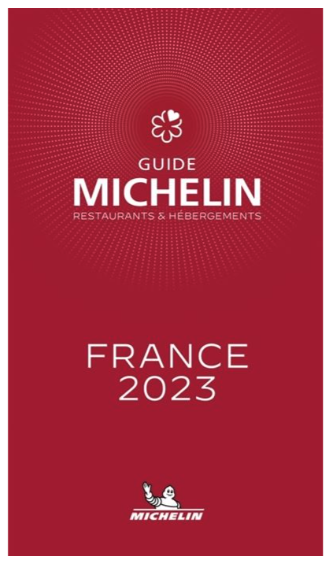Unsure about your French table manners? Click Here to download > > How to avoid these 10 food etiquette mistakes !
- Home ›
- Destinations ›
- Lyon ›
- Lyon: Food Capital of the World
13 Reasons They Call Lyon "Food Capital Of The World"
It took a few centuries for Lyon to claim the title of food capital of the world - plus the work of a few culinary giants. Here's how France's foodie city made it to the top (and yes, I've eaten my way through the city, waistline as evidence!)
If Lyon is often called the food capital of the world, it owes it to the food titans who transformed the city's culinary scene – and made sure everyone knew about it: people like Curnonsky, the food critic, or Bocuse, the great chef (precursor of the Nouvelle Cuisine movement), or the "Mothers of Lyon", the female chefs who once fed the city's working class.
I live near Lyon and enjoy "researching" in person, possibly a little too often. Even so, I'm not quite finished yet.
NOTE: Pages on this site may contain affiliate links, which support this site. See full Privacy Policy here.
Before I get involved with HOW Lyon became such a foodie magnet, let's look at the WHY.
The foodie specialties of Lyon
Lyon has some 4000 restaurants (including 16 with Michelin stars in 2023), in addition to its markets and food emporia and food festivals and culinary competitions, more than enough for you to sample its specialties for days on end without stopping to take a break.
One way to visit Lyon is to work your way through the Guide Michelin... whether the high end, or the much more affordable Bib Gourmand classifications!
Lyon is home to a host of fine foods, both gastronomic and local, earthy. Some of these are easy to love (for the non-Lyonnaise palate), while others may take a bit of getting used to.
I have to admit that there are a very few of these fine foods, such as the Tablier du Sapeur (breaded, fried tripe) I will likely never embrace! But part of the adventure is to keep exploring.
What about you? Have you tried these specialties of Lyon? Would you want to?
Charcuterie
Charcuterie is the generic name for cold cuts or meat products more broadly. In Lyon, this generally means pork. It is, in fact, often called "cochonaille", with "cochon" being pig.
Here are some of the most common:
- Andouillette: More delicious than it sounds, this is a coarse sausage made from pork intestines and seasoned with wine and onions, usually served with a mustard cream sauce. I have a particular weakness for this, but it has to come from a butcher shop, not a supermarket (industrial!)
- Boudin: known as black pudding or blood sausage, this dish – pan-friend with apple slices – is heavenly. When I eat this with a Gratin Dauphinois, I feel I've grown wings.
- Rosette de Lyon: A dried pork sausage cut in thick slabs and a little chewy, but with a delicious taste.
- Other types of charcuterie include saucisson à cuire (literally, sausage for cooking), Jésus (yes, you read correctly), and cervelas, which is eaten hot or cold.
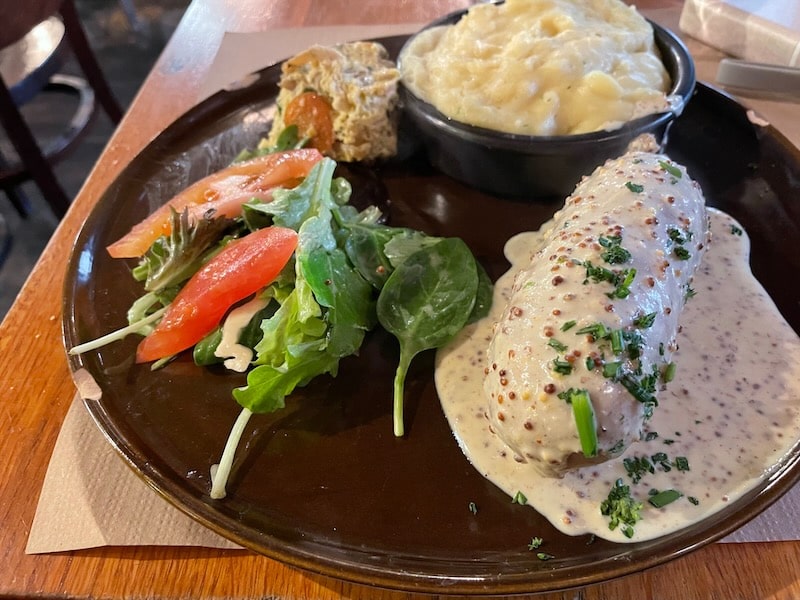 Andouillette with a mustard cream sauce
Andouillette with a mustard cream sauceMeat and fish dishes
In addition to pork, Lyon and the larger area around it is home to plenty of topnotch products, the most famous of which is undoubtedly...
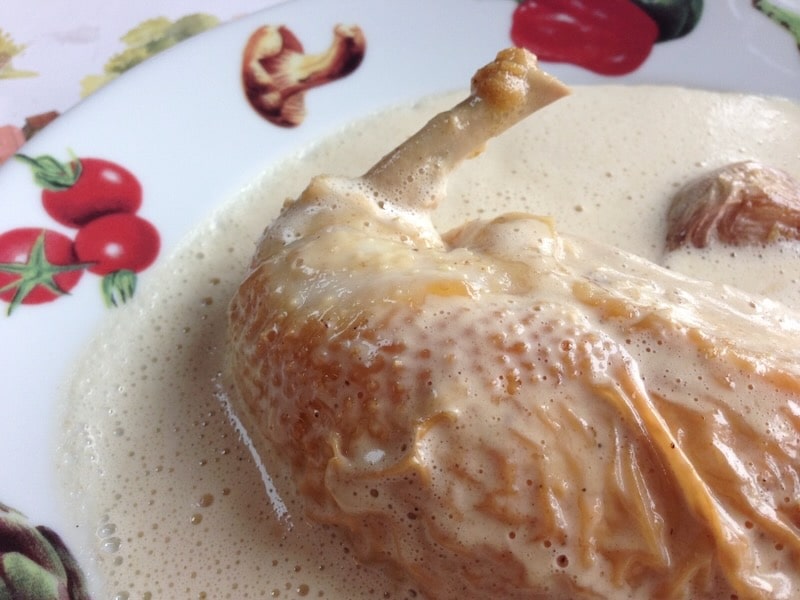 Chicken from the Bresse region, considered the "best chicken in the world"
Chicken from the Bresse region, considered the "best chicken in the world"- Poulet de Bresse: This may be one of the world's most expensive chickens (I've paid upward of US$ 60 for one) but it is without a doubt the best I have ever eaten. So special is it that France protects it with an appellation contrôlée label, the first (and possibly only) chicken in the world protected by law. The Bresse region is down the road from me and whenever I happen to drive through, I make sure I time my arrival for lunch. Preferably for some chicken with morel sauce, "sauce aux morilles".
- Tablier de sapeur: This is a classic of Lyon, but you need to like tripe. This one is marinated and fried, but I haven't been able to develop this particular addiction yet. Be forewarned, though: wherever you turn in Lyon, you'll find offal...
- Quenelles: These aren't technically charcuterie but don't really fit anywhere else. They're an oblong-shaped sausage usually made of brochet, or pike, mixed with semolina, eggs and milk and typically served with crayfish-based Nantua sauce, named after the town of Nantua in the Jura Mountains (not far from where I live). This particular dish, by the way, was apparently featured at Versailles under Louis XC.
- Escargots: Yes, snails. While they are usually eaten "Burgundy style", with parsley and garlic butter sauce, they are nonetheless local and several areas around Lyon are known for their snail farms.
- Salade lyonnaise: With all the heavy eating, you may yearn for a salad... don't be fooled. There is nothing “light” about a Lyonnaise salad and it can be a full meal of fresh lettuce, pork lardons, crispy croutons, and a poached egg.
Cheeses
The many farms around Lyon provide some excellent cattle and, better yet, cheese.
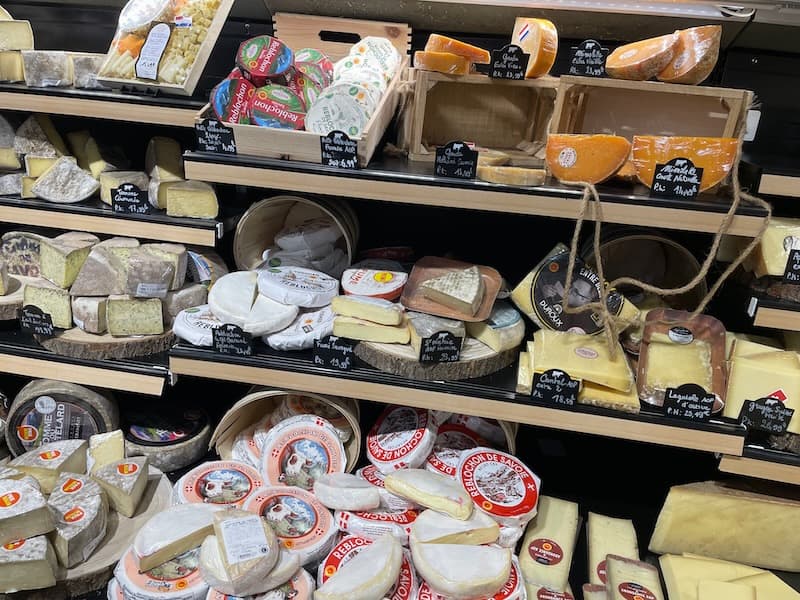
- Mont-d’Or: Apparently Louis XV (who appears to have been quite the gastronome) loved this cheese, and that gives me something in common with the defunct king. Come winter, the Mont-d'Or goes into the oven, studded with garlic and smothered in white wine. Once melted, you scoop out the insides with a spoon and ladle it over boiled potatoes or chunks of bread.
- St Marcellin: This is a small cow's milk cheese that has migrated pretty much everywhere across France. It's a little crusty on the outside but unctuous inside. A similar cheese is the St Félicien.
- Fourme d’Ambert: This is a blue cheese, one of the oldest cheeses in France, and extremely popular (I take the experts' word on this, because blue cheese and I aren't friends).
- Cervelle de canut (translates literally to silk worker’s brains): This is a cream cheese and contains onions and garlic, often served after the meal. It's one of my favorite local cheeses after a heavy meal.
When you visit the Halles Paul Bocuse, stop at Mère Richard and pick up some cheeses from across the region. The ones I've listed above are just a selection; there are many more.
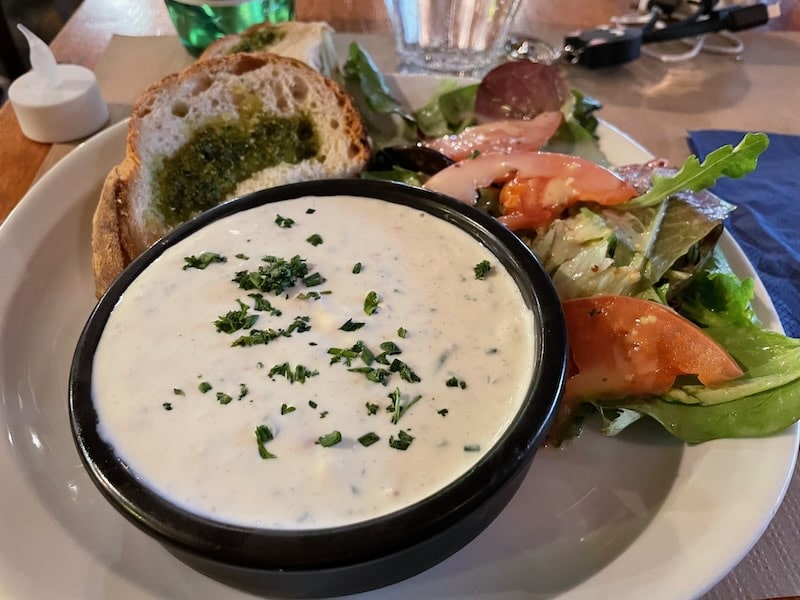 Cervelle de Canut, a typical creamy Lyon cheese
Cervelle de Canut, a typical creamy Lyon cheeseSweets and snacks
As with most foods in Lyon, expect the sweets to be heavy, either fried or thick with sugar. There are some fantastic patisserie shops in Lyon, but what they sell isn't native to the city, except perhaps for:
- Bugnes: Often eaten at holidays, these are light little pastries fried in oil, a bit like donut dough, and sprinkled with icing sugar. Don't eat them if you're wearing black!
- Coussins de Lyon: These are little green candies shaped like pillows, or "coussins", with marzipan and chocolate ganache.
- Pralines roses: You need strong teeth but they are basically almonds covered in crunchy colored sugar. Pralines are used in cooking, including as pies or in brioches.
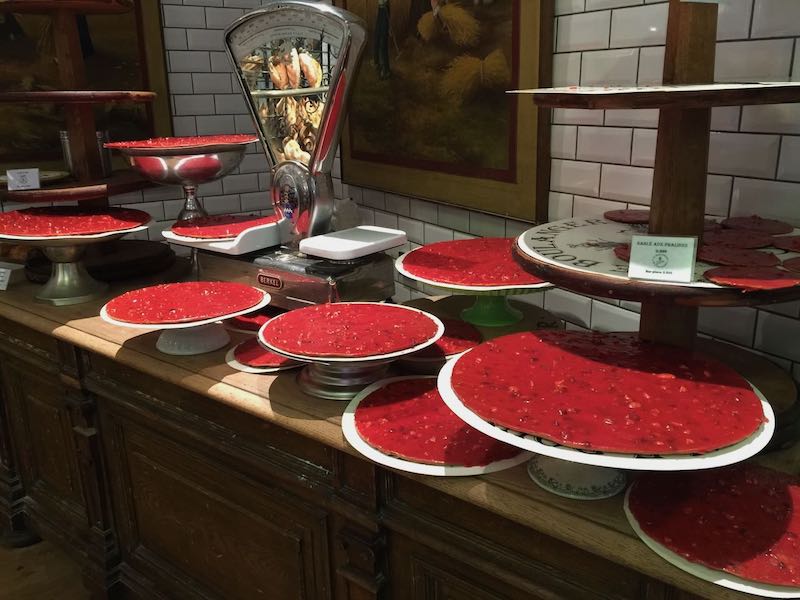
Wines
Grapes have been grown here since Roman times, and vineyards once adorned the hills of Lyon.
No more, but they aren't far away: Lyon is located right between the Beaujolais and the Côtes du Rhône regions, which yield wines of international repute.
If you can, take advantage of your trip to discover some of the best wineries in or around Lyon.
If you happen to be in Lyon the 3rd Thursday of November, head for the hills – the villages of the Pierres Dorées are the perfect backdrop – to sample the Beaujolais Nouveau.
13 Reasons to call Lyon "food capital of the world"
There's no shortage of reasons for Lyon's stellar reputation.
- The excellence of individual products themselves have helped catapult Lyon towards fame.
- Lyon's location is ideal. It is in one of France's most fertile regions, and the surrounding areas of Bresse, Dombes, Savoie, and Dauphiné provide a rich array of local ingredients, including high-quality poultry, freshwater fish, game, snails, fruits, vegetables, and wines.
- The city owes a lot to its history and its prosperity from the silk trade: all those silk workers had to be fed, which led to a proliferation of eating places and helped fuel the development of gastronomy.
- Lyon has star power. Although it has no Michelin three-star restaurants (Bocuse's Auberge de Collonges-au-Mont-d'Or, lost its third star in 2020, two years after his death), it has 16 two- and one-star establishments, and plenty more either in surrounding villages or mentioned at different levels of the Michelin Guide.
- The famous "mères", or mothers, were chefs who left domestic cooking to open their own restaurants. These would have a major influence on Lyon's culinary scene and set the stage for future generations of chefs who cut their culinary teeth in their kitchens.
- A number of influential chefs and culinary figures helped boost the city's reputation – including native son Paul Bocuse, nicknamed the "chef of the century".
- As does Paris with its "bouillons", Lyon has its own traditional eateries, the "bouchons", which serve as the backbone of the city's food scene with their authentic, local cuisine.
- Lyon caters to a wide range of palates and budgets, from high-end dining to street food.
- The city is home to a number of culinary institutions, producing chefs who often stay in Lyon to contribute to its food culture.
- Lyon attracts culinary talent from around the world, and these chefs often bring innovative techniques and flavors, enriching the city's gastronomic landscape.
- From the grand Les Halles de Lyon Paul Bocuse to local farmers' markets, Lyon offers dozens of venues to procure top-notch ingredients.
- Lyon frequently appears on lists of the world's best food cities, providing international acclaim and attracting food tourists.
- Possibly the best guarantee of Lyon's culinary status are the Lyonnais themselves: they are deeply passionate about food, and their enthusiasm helps sustain the city's culinary reputation.
These are just a few of the factors that contribute to Lyon's gastronomic greatness. But was it always like this?
A brief look at Lyon food history
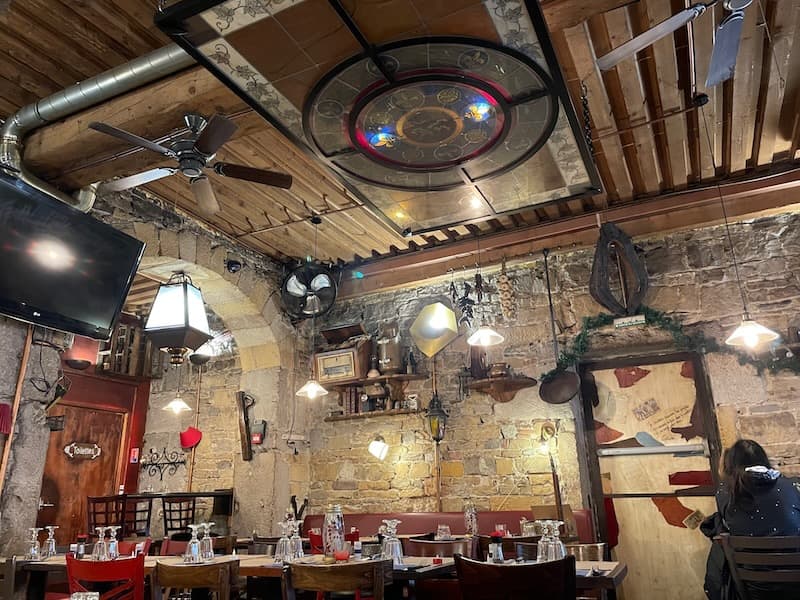 A common bouchon "look" in Old Lyon, although many are sleek and modern (but still serve traditional foods of Lyon)
A common bouchon "look" in Old Lyon, although many are sleek and modern (but still serve traditional foods of Lyon)The silk trade
It all began back in the Renaissance, when Lyon positioned itself as a center of culture and commerce.
With newfound wealth – much of it from the silk trade – came a refinement of the bourgeois palate. Not only were local products increasingly diverse and delicious, but Lyon's geographical position at a crossroads of trade routes and rivers opened it up to foreign influences and tastes.
Much of the influence came from Italy, whose merchants traveled to Lyon for trade fairs or to work as librarians or printers.
The mothers, or "Mères Lyonnaises"
Somewhere around the mid-18th century, domestic cooks in those wealthy bourgeois homes expanded their skills. As the silk trade waned, money became scarce and households had to let their cooks go.
These cooks, mostly women, began opening their own establishments, providing generous authentic cuisine to the city, and if Lyon's cuisine has succeeded so well, it's largely because of them.
They became known as the "Mères lyonnaises", or Mothers of Lyon.
Some became icons, like Eugénie Brazier, the first woman to earn three Michelin stars and in whose kitchen future Michelin chefs, like Paul Bocuse, would earn their stripes.
Curnonsky's words
A key player in building Lyon's reputation was a certain Curnonsky, born Maurice Edmond Sailland. He was the 20th century's most famous food writer and critic and was elected "Prince of Gastronomes" in a public referendum.
Legend has it that on any given night, 80 Paris restaurants would keep a table free – just in case he showed up. He founded countless food-related associations and prizes and was the author of France's first gastronomic travel guide (among many other writings).
To him we owe Lyon's nickname as the "food capital of the world", or in French, the "capitale mondiale de la gastronomie", and he did much to promote not only French food but Lyon's place in it.
Bocuse and beyond
If Lyon has one chef who embodies its culinary traditions, that chef is the late Paul Bocuse, whose Auberge du Point de Collonges held its three Michelin stars for 55 years before losing one.
Such is the respect for Bocuse in Lyon that it is difficult to traipse around the city without stumbling upon his name, trace or influence, from wall murals to the Halles Paul Bocuse, an extraordinary food market near the Part-Dieu train station which houses some of Lyon's best food shops (and yes, you can eat there too).
Lyon's famed culinary institute, the Institut Paul-Bocuse, wore his name for years until a dispute with the chef's son about its direction led to its rechristening as Institut Lyfe. I liked the old name better...
While Bocuse may have embodied Lyon, others today are taking the city's culinary traditions forward, like the amazing Matthieu Viannay, who now heads the kitchen at the Mère Brazier, or Guy Lassaussaie at Bulle, next to Fourvière Basilica, or (my favorite) Christian Tetedoie, who runs several restaurants in Lyon.
The various types of Lyon eateries
One of the factors propelling Lyon to culinary stardom is its diversity of places to eat.
- Mâchons – after a long night's work, silk workers ate hearty, rich morning meals. These almost disappeared from Lyonnais fare but are now undergoing a revival, mostly in the few "bouchons" which serve this meal early in the morning
- Bouchons – small, casual restaurants serving traditional, richly flavored dishes
- Brasseries – mostly established by Alsatian immigrants fleeing Germany's invasion of their land, and specializing in such northern dishes as sauerkraut – and beer
- Bistrots – small, inexpensive restaurants
- Restaurants and haute cuisine – Lyon is spoiled, with its Michelin-starred restaurants but also the many more of equal quality and stature
- Food festivals – from the Salon du Chocolat, through the Lyon Street Food Festival (I haven't missed one in years) or the elite Bocuse d'Or world competition
- Markets – every neighborhood has one, but the largest and best are undoubtedly on Croix-Rousse Hill and on the Quai St Antoine along the Saône
- Cité Internationale de la Gastronomie – part museum, part restaurant, part workshops... this is the new kid on the block, housed in the beautifully renovated Hotel-Dieu. I have yet to get my head around the essence of this food establishment... but people who visit have plenty of good things to say about it.
Before you go...
So IS Lyon the food capital of the world?
You'll have to come and decide for yourself, but the French grudgingly agree it might just be the food capital of France, quite the accolade in a country so proud of its culinary traditions.
That said, eating out and exploring Lyon foodie sites is one of the most fun things to do in Lyon. You can explore on your own in discovery mode, or you can take a Lyon food tour as an introduction.
While you're here, make sure you visit at least a few of the city's giant outdoor murals, and on a clear day, head up to Fourvière Hill for the best views of the city from above.
Ready for your Lyon trip?
Here are some suggestions to make your visit even more enjoyable!
TOP LYON CITY TOURS
➽ Vieux Lyon 4-hour Food Tasting Tour - for inveterate foodies and gastronomes
➽ Discover Lyon Walking Tour - to explore the essence of the city
LYON DAY TRIPS
➽ Golden Stones Beaujolais - heart of the Golden Stone villages for wine lovers
➽ Northern Côtes du Rhône - meeting the winemakers
➽ Beaujolais and Pérouges - wine tasting and a medieval village visit
WHERE TO STAY IN LYON
➽ Villa Florentine - stunning 5-star luxury overlooking the entire city
➽ Mi-Hotel Tour Rose - perfect apartments in historic Vieux Lyon
➽ Fourvière Hotel - elegant simplicity in a former cloister
➽ Hotel du Théatre - budget option in the heart of the classical district
Renting a car in Lyon? Compare prices here.
Traveling here by train? Book your ticket here.
To see the city, don't forget to book your Lyon City Card.
Did you enjoy this article? I'd love if you shared it!
